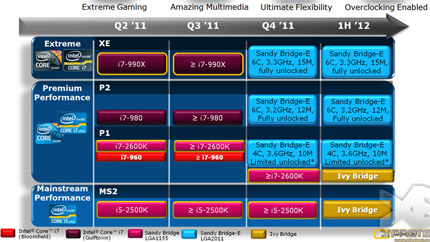Bridge over the river Intel
Whisperings in the tech industry suggest that Intel will be axing the top-line X58 chipset - home to the Core i7 900-series processors - and replacing it with the X79 later this year.
X79 will be home to a new range of Intel Sandy Bridge processors that are dubbed 'Extreme'. Based on an all-new LGA2011 socket and home to four memory channels, Sandy Bridge Extreme seems meaty at first glance, if the reports are to be believed.
Now it seems as if the rumour-mongering machine that is XFastest has what appears to be a genuine Intel desktop enthusiast roadmap which delineates the Sandy Bridge Extreme chips in a little more detail.
Click to enlargeThere are a few interesting tidbits we can take out of this roadmap. First off, the Core i7 990X will be the last hurrah for the X58 chipset and LGA1366 form factor. Goodbye, old friend.
What also seems apparent is that Intel will keep the incumbent Core i7 2600K Sandy Bridge processor as a premium mid-range chip, rather than elevate it via a clock-speed jump to a genuine 'Extreme' model. That's a little surprising given the imminent arrival of the supporting Z68 chipset.
Sandy Bridge Extreme will debut on the LGA2011 platform in at least three guises. Four core (presumably multi-threaded) chips will pack an impressive 10M of last-level cache, while the genuine performance variant will ship with six cores and up to 15MB of LLC. The cache levels are significantly higher than the current setup, meaning Intel is going to have make a lot more silicon room for this chip.
Appreciating how Intel's segmentation works and the likely prices that each class of CPUs attract, the cheapest SBE will be around $300, rising to $999 for the very best model.
But perhaps most interesting of all is the inclusion of the next-generation 'Ivy Bridge' chips as mainstream products in Q1 2012. These processors are largely based on established Sandy Bridge technology but reduce the process node from 32nm to 22nm. Reports indicate that the integrated graphics portion will see a bump to DX11, while overall like-for-like performance is expected to jump by around 20 per cent against same-clocked Sandy Bridge processors.














